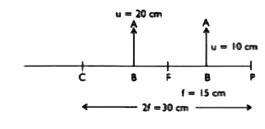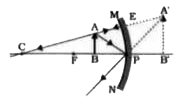InterviewSolution
Saved Bookmarks
| 1. |
Suppose you have three concave mirrors A, B, C of focal lengths 10 cm, 15 cm and 20 cm. For each of these concave mirrors, you perform the experiment of image formation for three values of object distance of 10 cm, 20 cm and 30 cm. Answer the following reasons. (a) Identify the mirror/mirrors with linear magnification - 1.(b) Out of the three mirrors, identify the mirror which would be preferred to be used for shaving purposes/makeup.(c ) For the mirror B, draw ray diagram for image formation for object distance 10 cm and 20 cm. |
|
Answer» Solution :(a) `{:("Concave MIRROR","f cm","u cm","u cm","u cm","2f cm"),("A",10,10,20,30,20),("B",15,10,20,30,30),("C",20,10,20,30,40):}` • Magnification |m| = 1 means IMAGE size is equal to object size •For a concave mirror, image size is equal to object size when the object is at C, the centre of curvature. [r = 2f] • Concave mirror A FORMS image which has the same size as the object when u = 20 cm [ie u = 2f] • Concave mirror B forms image which has the same size as the object when u = 30 cm •Concave mirrors A [at u = 20 cm] and B [at u = 15 cm] has linear magnification - 1. (b) For a concave mirror to be used as a make up mirror or shaving mirror, the object should be within the pole and the PRINCIPAL focus. Concave mirror B [u = 10 cm and u = 20 cm] Concave mirror C [u = 10 cm, u = 20 cm, u = 30 cm] (c ) Ray diagram for concave mirror B for object positions u = 10 cm and u = 20 cm  When u = 10 cm, Object is between P and F  When u = 20 cm, object is between F and C 
|
|